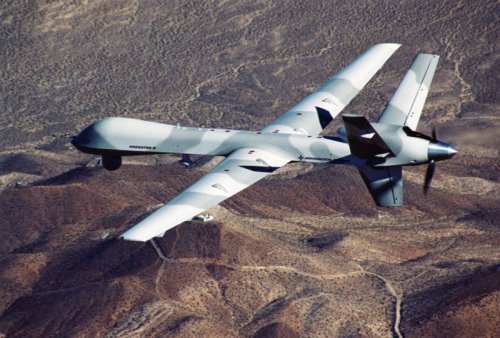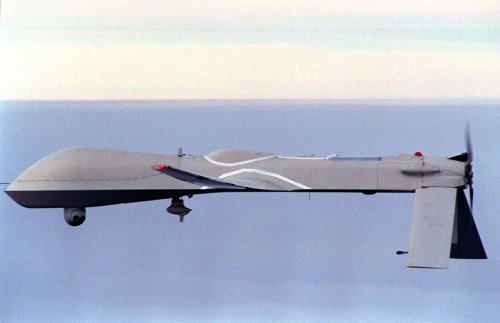A
You are using an out of date browser. It may not display this or other websites correctly.
You should upgrade or use an alternative browser.
You should upgrade or use an alternative browser.
- Joined
- 4 May 2008
- Messages
- 2,440
- Reaction score
- 674
Good question. I can only offer more or less plausible causes:
Predator B was designed from the outset to carry weapons, as such the large inverted-V tails might have gotten in the way of the exhaust of powered munitions. Or maybe the structural integration of the turboprop engine worked best with the V-layout, but I doubt. Either way, flight qualities are probably the same provided the vertical and horizontal projected areas are the same. there might be a trade in spiral stability vs dutch roll, but i doubt you would really care, with an autopilot taking care of things.
It is interesting to note that the earlier GA Prowler had the opposite arrangement (inverted Y?)
Any other ideas?
Predator B was designed from the outset to carry weapons, as such the large inverted-V tails might have gotten in the way of the exhaust of powered munitions. Or maybe the structural integration of the turboprop engine worked best with the V-layout, but I doubt. Either way, flight qualities are probably the same provided the vertical and horizontal projected areas are the same. there might be a trade in spiral stability vs dutch roll, but i doubt you would really care, with an autopilot taking care of things.
It is interesting to note that the earlier GA Prowler had the opposite arrangement (inverted Y?)
Any other ideas?
Just call me Ray
ACCESS: Top Secret
- Joined
- 26 August 2007
- Messages
- 672
- Reaction score
- 42
The reason why the Predator B (Reaper) has its rear control surfaces the way they are is simple - that way, the enlarged control surfaces compared to the MQ-1 will have less of a chance of being struck upon rotation without the need for longer landing gear or folding surfaces.
Why the MQ-1 isn't like that then, I have no idea. Maybe General Atomics just felt like being different.
Why the MQ-1 isn't like that then, I have no idea. Maybe General Atomics just felt like being different.
- Joined
- 4 May 2008
- Messages
- 2,440
- Reaction score
- 674
Predator A's ancestry includes the Teal tube launched cruise missile (I believe that was the name), whose wing had a fuselage mounted pivot. The wing would swivel and stow longitudinally on top of the fuselage. That precluded the installation of an 'upright' tail. My guess is, Abe Karem's attitude must have been to save development money and keep things the way they were for the successive vehicles (engineers are a lazy bunch...i should know!)
I was searching the forum for Teal references and found none. the development of that family of vehicles is varied and fascinating. Maybe I should start a thread on this...
I was searching the forum for Teal references and found none. the development of that family of vehicles is varied and fascinating. Maybe I should start a thread on this...
- Joined
- 4 May 2008
- Messages
- 2,440
- Reaction score
- 674
hmph...I guess i should check my references before quoting by memory. The program name was TEAL RAIN, and the vehicle's name was Amber. Abe Karem's Leading systems of Irvine, CA, designed it, went bankrupt, ad now GA is selling those things faster than they can make'em.
here you can find a decent picture of Amber, with the pylon mounted wing clearly visible.
http://spyflight.co.uk/Predator.htm
for more info:
http://en.wikipedia.org/wiki/The_prehistory_of_endurance_UAVs
The inverted allowed a longer wing to fold above the fuselage, and as mentioned before had the nice synergistic effect of protecting the prop.
here you can find a decent picture of Amber, with the pylon mounted wing clearly visible.
http://spyflight.co.uk/Predator.htm
for more info:
http://en.wikipedia.org/wiki/The_prehistory_of_endurance_UAVs
The inverted allowed a longer wing to fold above the fuselage, and as mentioned before had the nice synergistic effect of protecting the prop.
A
avatar
Guest
hey thanks for the replies.
it seems that the distance between the tail surfaces in the case of the Reaper is greater than that in the case of the predator.
it seems that the distance between the tail surfaces in the case of the Reaper is greater than that in the case of the predator.
- Joined
- 17 October 2006
- Messages
- 2,281
- Reaction score
- 604
The moment arm on the Reaper is relatively shorter. An inverted V-tail would be too large for ground clearance.
Mithrandir
ACCESS: Restricted
- Joined
- 13 April 2009
- Messages
- 10
- Reaction score
- 0
notice the "B" (Reaper) has control surfaces and the "A" has full flying tails...
The tails on the AMBER were also full flying and would fold back as well as the prop folding back and the outer wing panels would fold under the main panel and it would pivot on the pylon so it could be stowed nearly assembled in a small container.... also this was the configuration for the Rocket Launched "Option One" as it was called within LSI.
The tails on the AMBER were also full flying and would fold back as well as the prop folding back and the outer wing panels would fold under the main panel and it would pivot on the pylon so it could be stowed nearly assembled in a small container.... also this was the configuration for the Rocket Launched "Option One" as it was called within LSI.
"Air Force announces official retirement date for iconic MQ-1 Predator drone"
by Stephen Lousy
Source:
https://www.airforcetimes.com/news/your-air-force/2018/02/16/air-force-announces-official-retirement-date-for-iconic-mq-1-predator/?utm_source=Sailthru&utm_medium=email&utm_campaign=EBB+2%2F20%2F18&utm_term=Editorial+-+Early+Bird+Brief
by Stephen Lousy
Source:
https://www.airforcetimes.com/news/your-air-force/2018/02/16/air-force-announces-official-retirement-date-for-iconic-mq-1-predator/?utm_source=Sailthru&utm_medium=email&utm_campaign=EBB+2%2F20%2F18&utm_term=Editorial+-+Early+Bird+Brief
The Air Force will officially retire its iconic, groundbreaking — and controversial ― MQ-1 Predator on March 9, officials at Creech Air Force Base said.
In a Wednesday release, Creech said that the Air Force will shift to entirely using MQ-9 Reapers for combat missions after the Predator’s sunset. The Air Force also flies unarmed RQ-4 Global Hawks for reconnaissance missions.
First Lt. Annabel Monroe, a spokeswoman for Air Combat Command, said that the Air Force is still figuring out what it will do with its retiring Predator fleet. Some could be transferred to Air Force museums, and the Air Force is exploring the possibility of transferring some to the Navy.
But the Air Force won’t sell them to private organizations, Monroe said, and does not expect to sell or give them to allied nations through the Excess Defense Article Program for Security Cooperation.
And while the active duty Air Force and Air National Guard will stop flying the MQ-1 after March 9, contractor flights in the Middle East will continue through December, she said.
The Predator was a landmark in the development of the military’s use of remotely-piloted aircraft. The Air Force first deployed the unarmed reconnaissance version of the Predator, the RQ-1, in Albania in July 1995, and also set up Air Combat Command’s first Predator unit that month.
The Predator had a checkered level of success in the early days. Creech said several RQ-1s were shot down early on, and others crashed due to infrastructure problems. But air crews kept tweaking the design to improve its flight capabilities, such as by adding helicopter missile pylons and switching to a more reliable turbo engine. It was also tweaked to do something it wasn’t originally intended to do: Carry and fire ordnance such as Hellfire missiles.
Unarmed Predators were used to scout Afghanistan beginning a week after the Sept. 11, 2001, attacks. And on Oct. 7, 2001, the day strikes on Afghanistan began, the first armed mission with a Predator was carried out — this one by the CIA, unsuccessfully targeting Taliban leader Mullah Mohammed Omar ― and it ushered in a new era of warfare. That Predator, tail number 3034, now hangs in the Smithsonian National Air and Space Museum.
In 2003, Creech said, the Air Force developed the ability to allow pilots to fly RPAs from across the globe. This “remote-split operation” tactic beamed signals to RPAs once they took off, allowing RPA pilots to conduct missions from stateside bases such as Creech.
The Predator drone quickly became an iconic weapon ― and one steeped in controversy. The RPA’s ability to loiter for long periods watching potential targets, and then to fire precision-guided munitions without putting American or allied troops at risk, made it very attractive to the Pentagon. The Obama administration dramatically increased the number of drone strikes as a key part of its counterterrorism strategy.
But critics blasted President Obama for civilian casualties caused by Predator and other RPA strikes, which they said were much higher than the administration acknowledged.
Afghans even began weaving images of the Predator in their traditional “war rugs,” which previously incorporated images of Kalashnikovs, tanks, helicopters, and other Soviet weaponry from the USSR’s occupation.
In 2011, the Predator and Reaper combined marked their one millionth combat hour flown, about a decade after the Predator began flying in Afghanistan. In a sign of how much the military had grown to rely on RPAs, those drones hit 2 million combat flying hours two years later.
The Predator and Reaper also continued to play critical roles in Operation Inherent Resolve, the conflict against the Islamic State that began in 2014.
Similar threads
-
-
-
-
Light-Attack Plane Could Save USAF Millions of Dollars Per Year
- Started by bobbymike
- Replies: 38
-


